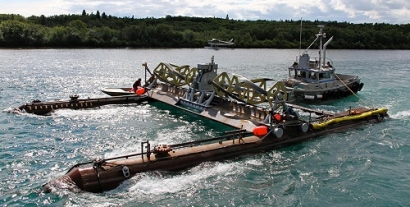This funding comes from the Office of Energy Efficiency and Renewable Energy’s (EERE) Water Power Technologies Office. A key goal of the water office is driving down the cost of energy from marine energy devices.
The Igiugig Village Council (IVC) in Alaska, in partnership with the Ocean Renewable Power Company of Maine, was selected to receive $2.3 million in funding to further design, construct, and test the RivGen cross-flow river current turbine system, and incorporate improved IO&M strategies early in the design phase, resulting in improved operational costs and device availability.
The RivGen® Power System generates emission-free electricity from river currents and connects directly into existing remote community grids using smart grid technology. It consists of three major subsystems: shore-side power electronics, mooring system, and turbine generator (TGU) device.
"Marine energy technologies have the potential to provide millions of Americans with locally sourced, affordable, and reliable energy," said Daniel Simmons, Principal Deputy Assistant Secretary for EERE. "This is why DOE’s research and development is critical to advancing American economic growth and energy security, especially for rural communities that have high energy costs but abundant marine energy resources."
Five additional projects were selected to receive $4.4 million from EERE to address technology development challenges for marine energy systems. The additional five selected projects are as follows:
- Seawater Compatible Rotary Pump for Wave Energy Conversion: Resolute Marine Energy (RME) of Boston, Massachusetts, will incorporate a marinized rotary pump with a hydraulic Power Take-Off (PTO) system that can be employed in wave energy converters. RME, in coordination with Ricardo, University of Minnesota, Re Vision Consulting LLC, Austin Power Engineering, and Charles River Hydraulics plans to build and test a model-scale seawater-compatible pump to facilitate lab testing of a PTO system that can implement real-time controls; and perform endurance tests of the pump seals.
- Design of high-deflection turbine blades for marine energy applications: Ocean Renewable Power Company (ORPC) of Portland, Maine, will team up with the University of New Hampshire, DoyleCFD, AeroCraft, and Sandia National Laboratories to investigate low stiffness cross-flow turbines to increase turbine efficiency by reducing the number of internal supports and adjusting designs to reduce tip losses. This project aims to produce a 20% increase in efficiency and a 20% increase in annual energy production for a crossflow turbine.
- Advanced Linear Hybrid Power Take-Off for Wave Energy Conversion: Oscilla Power, Inc. (OPI) of Seattle, Washington, will improve and optimize OPI’s linear hybrid drivetrain technology to be able to achieve a rated capacity of over 400 kW per drivetrain while staying within subsystem cost, mass, and size targets. This project aims to demonstrate the effectiveness of these advancements through detailed laboratory 1/10th scale testing at Sandia National Laboratory and demonstrate >85% efficiency for the improved PTO in a range of simulated sea states.
- Novel Wave Energy Converter Concept: Enorasy of Bedford, Massachusetts, in partnership with Raytheon, University of Maine, and Draper Labs will build a 1/10th scale prototype of a unique wave energy converter that utilizes a rotating mass and control system to absorb power in a new and very efficient manner. This project will utilize performance metrics developed under the recent Energy Department Wave Energy Prize, and will focus on numerical modeling, simulation, fabrication, assembly, testing, and performance validation at the University of Maine wave test tank.
- Water Horse Hydroelectric Harvester Development: In coordination with Alaska Center for Energy and Power (ACEP), and Renergé, Inc., University of Alaska Fairbanks will incorporate design modifications on an oscillating hydrokinetic harvester, the Water Horse. The Water Horse technology operates using passive, rather than active system controls, to lower the overall cost of energy and reduce system failures. The technology may have promise for small, remote riverine applications where deployment of large tidal turbines could be challenging due to water depth limitations.


